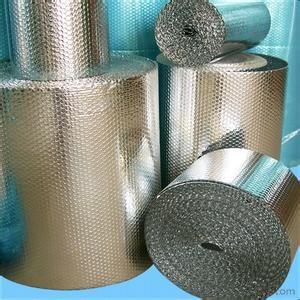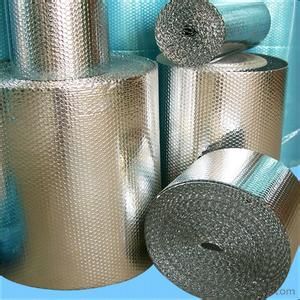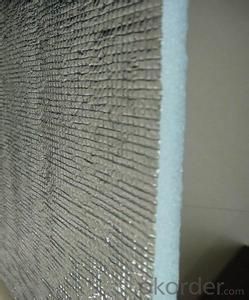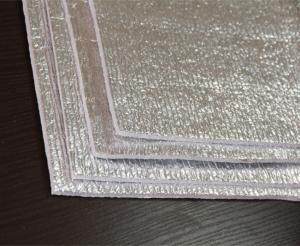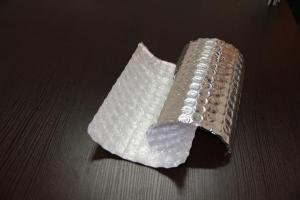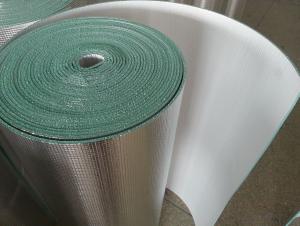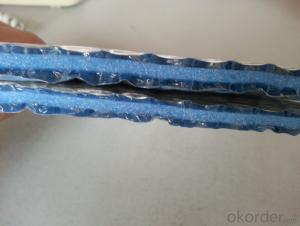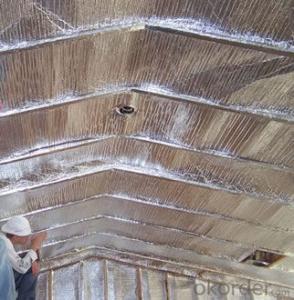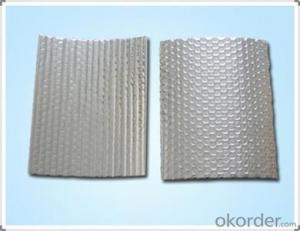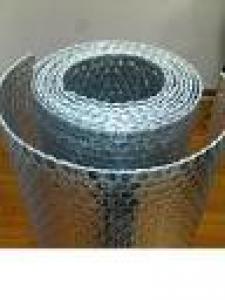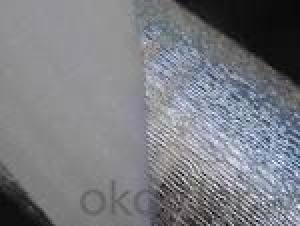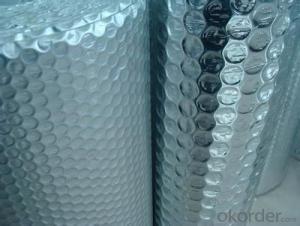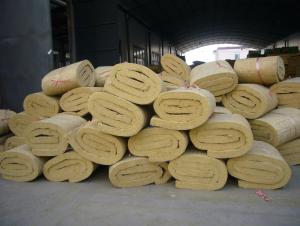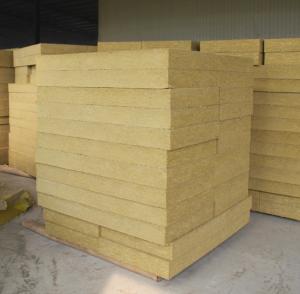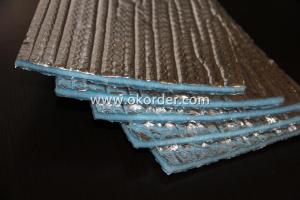Roofing Insulation Material - Aluminum Foil Coated Bubble Insulation Type 3
- Loading Port:
- Shanghai
- Payment Terms:
- TT OR LC
- Min Order Qty:
- 10000 m²
- Supply Capability:
- 100000 m²/month
OKorder Service Pledge
OKorder Financial Service
You Might Also Like
Bubble Insulation Benefits:
Reflects 96% of radiant heat
Non-toxic / Non-carcinogenic
Does not require protective clothing or respirators to install
Durable and lightweight
Does not compress, collapse or disintegrate
Vapor and radon retarder
Easy to cut and install
Permanent and maintenance-free
Does not provide a growth medium or nutritive value for fungus, insects, or rodents
Does not support the growth of mold or mildew
Not affected by moisture or humidity
Lowers heating and cooling costs year round
Bubble Foil Application:
Metal & Steel Buildings
Homes
Roof Underlayments
Cathedral Ceilings
Crawl Spaces
Hot Water Heaters
Basement Walls
Floors
Garage Doors
Concrete slabs
Driveway snow melts
Pole barns
Post frame buildings
Poultry barns
Animal kennels
Temperature sensitive storage areas
Air Bubble Foil Insulation Tech Data:
Material Structure: AL/Bubble/AL | ||
Bubble Size:D10mm*H 4mm(10*2.5/10*4/10*6/20*7/25*10)choose the bubble size | ||
Bubble Weight:0.13kg/m2 ( can be customized ) | ||
Roll Width:1.2m (lenth can be customized) | ||
PROPERTIES | TEST DATA | UNIT |
Thickness | 3.5-4 | mm |
Weight | 250 | g/m2 |
Emissivity | 0.03-0.04 | COEF |
Thermal conductivity | 0.034 | w/m0 |
Apparent Density | 85 | kg/m3 |
Reflectivity | 95-96 | % |
Water Vapour Transmission | 0.013 | g/m2kpa |
Corrosion | doesn't generate | |
Tensile Strength(MD) | 16.98 | Mpa |
Tensile Strength(TD) | 16.5 | Mpa |
- Q: As opposed to other roof structures, such as Mansard or Hipped roofs. If so, is it because there is a lesser distance between the internal heat source and the roof?
- No, it really does not matter what type of roof as long as the insulation is well done. But of course in a flat roof it is easier to reach all the points with ease whereas in sloping roof some areas may be inaccessible. But, with blow-in insulation that is not a big problem.
- Q: the roof of my mouth hurts bad.i worked all day with sawdust and insulation yesterday.is this the problem.?
- The okorder , and see if I could find out anything there, if not I'd see my doctor. Insulation can get into your lungs and nasal passages and do a great deal of damage. That's why you should always wear a mask when woking with it. I would'nt worry too much about the sawdust.
- Q: were can i buy material to insulate pans and instructions to install it? I have seen many roofs with this done ,but , the lowe,s and home depots don't have .
- metal pan usually refers to a pan that concrete is then poured into. If there is no concrete in it (and a flat membrane roof over that) then its called currogated metal roof. Either way they look the same. Hard to insulate cause they are not meant to insulate. there are some sold with insulation already attached - its a thin floam layer - thats a newer thing but not sure how new. heard of some mobile home mfgs and storage building builders using spray on insulation under the panels. As for aftermarket on insulating- you may be able to have spray on insulation applied from under neath - if the space is open and accessible. it looks and feels like foam, can get a bit messy , but maybe do-able depnding on your application. If its not a open space with maybe drywall under it - you might think about opening up the space in the ceiling and having blown in insulation done (much cheaper then sprayed on). Blown in will insulate just fine but someone would have to look at your application and area cause in some instances - blown in insulation can be bad for high moisture situations. also- if this happens to be in a house - by adding insulation to steel - you might be breaking fire code - something to keep in mind for safety.
- Q: Like how does it get put in your roof?I am doing this energy efficient house.Other Questions:What is an Eave?Whats the roof on top of a patio called?What does orientation mean?What are the good things about French doors?
- It can be blown in or more often it comes in large bagged bales and you cut and dump in the attic. The eaves are the portion of the roof that overhangs/extends past the wall. It's usually called a patio cover Orientation is how the home (or other structure) is positioned on the lot. They let in lots of light and are very attractive.
- Q: Hi, my building is hot in temperature in summers, so I am finding ways to tackle the problem by placing some heat insulating materials against the sunlight on the roof of my building. I have found several possible solutions, but none of them close to perfect. 1. grass layer: hard to maintain2. heat-insulating brick: might be too heavy to carry them to the roof3. heat-insulating coating: would it be damaged if we step on them? Are there things like heat-insulating carpets that would be convenient to instal?
- If you're redoing the roof, a radiant barrier under the sheathing helps. So does insulation. And also, if there is an attic space there, consider putting in a fan to blow the hot air out.
- Q: on a traditional pitched roof construction,where is heat insulation usually provided?
- On the ceiling.Paper side down to help protect against moister.
- Q: Foam and the new building technolodgy's are coming to New Orleans. The rebuilding is causing New Orleans to be the "Greenest City in America". Energy Efficiency and the proper buiilding techniques tak hold.
- it is one of the strongest roof sealers and the best insulator available
- Q: Tax Question: Itemized receipt for roofing and insulation?
- The insulation is a tax deduction. Call the contractor and ask for an itemized reciept for tax purposes.
- Q: we have liq. ammonia storage tank (capacity 40000 ton)having double wall & suspended deck.liq. NH3 stored at temp -33 degree cent. insulation (form ) being provided to annular space (wall ) but not on top roof . can you explain for exact reason.with regardsanvar shaikh
- Insulation is less necessary on the roof. The ammonia is mostly a liquid, and a liquid would absorb heat rapidly from tank walls. Above the liquid is vapor, and vapor absorb heat much less rapidly than liquid does, so insulation is less important there.
- Q: I've found lots of building forums and general "building advice" columns that go over very high-level pros/cons to choosing roofing material and insulation options, but I want a site where I can see hard costs of ordering each of the materials so I don't have to call up a ton of contractors or dealers. Does such a comparison site exist? Everyone offers quotes, but that takes too much time to apply for quotes to every dealer.I'm specifically interested in knowing what green options I can afford (cotton batting vs. formaldehyde-free fiberglass, etc.).
- You could call ABC supply or Norandex Reynolds, they are the biggest distributors I know of. They may have some resources for you.
Send your message to us
Roofing Insulation Material - Aluminum Foil Coated Bubble Insulation Type 3
- Loading Port:
- Shanghai
- Payment Terms:
- TT OR LC
- Min Order Qty:
- 10000 m²
- Supply Capability:
- 100000 m²/month
OKorder Service Pledge
OKorder Financial Service
Similar products
Hot products
Hot Searches
Related keywords
